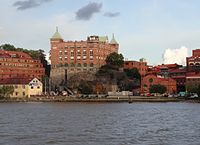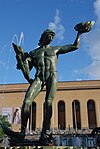Old Älvsborg
| Old Älvsborg | |
|---|---|
Gamla Älvsborg | |
Second Karl Gustav War |
Älvsborg (literally "river stronghold" in
History
During the Middle Ages, the Göta Älv was Sweden's sole point of access to the North Sea, as the coastline to the north (Bohuslän) was part of Norway until 1658, while the area to the south (Halland) was part of Denmark until 1645.[1] The river mouth, and by extension the heights at Klippan overlooking it, therefore had immense strategic significance.
Älvsborg Castle is first mentioned in written sources during the reign of King Albert (1364-89), but seems to have been built slightly earlier, most likely during the reign of his predecessor Magnus Eriksson.[2] Magnus certainly seems to have been responsible for the construction of another castle in the area, at Lindholmen on the opposite bank of the river. Indeed, Älvsborg may have been intended to replace Lindholmen, as the latter fortress fell out of use shortly after the construction of Älvsborg.[3][4]
In 1434, during the

The deposition of Erik and election of
Älvsborg was however attacked and captured in 1502 by Crown Prince Christian (the future King Christian II of Denmark-Norway), who burnt the castle to the ground. It was subsequently rebuilt by the Swedes, only to be captured again in 1519, and this time the Danes held onto it for four years, until the end of the Swedish War of Liberation.[7]
Älvsborg was strengthened and modernised by King Gustav I, transforming it from a mediaeval castle into a Renaissance fortress with up-to-date trace italienne outworks. In November 1545 the king decided to establish a new town adjacent to Älvsborg, to replace Nya Lödöse, and the new settlement was formally inaugurated in summer 1547, under the name Älvsborgs stad (Älvsborg Town).[8]

In 1563, when the
In 1612, during the
When the Swedish county system was established in 1634, Älvsborg became the capital and namesake of Älvsborg County, which comprised the traditional province of Dalsland and the western half of the province of Västergötland.[13]
The repeated capture of Älvsborg by the Danes demonstrated that the fortress was no longer defensible, in large part because the improved range and power of modern
In 1901 a
Legacy
Älvsborg gave its name to three subsequent fortifications, two of them also in the Gothenburg area (New Älvsborg and Älvsborg Fortress), while the third (Fort Nya Elfsborg) was in New Sweden, the Swedish colony in North America.
Älvsborg County was not renamed despite the transferal of its seat of administration to Gothenburg (and later to Vänersborg), and thus preserved the castle's name until 1997, when it was merged with the neighbouring counties of Gothenburg and Bohus and Skaraborg to form Västra Götaland County. Numerous organisations and private clubs in the area still use the name Älvsborg, most notably the sports club IF Elfsborg. A succession of warships in the Swedish Navy have also been named after Old Älvsborg, most recently the HSwMS Älvsborg.
Gallery
-
The Toppsockerfabrik, built on the outcrop Klippan overlooking theGöta Älv.
-
Klippan from the landward side, with both the Toppsockerfabrik and preserved ruins of Älvsborg visible.
-
Preserved ruins of Älvsborg, protected by a modern canopy.
-
The Älvsborg Bridge, with Gothenburg in the distance. The Toppsockerfabrik is on the right, partially obscured by the deck of the bridge.
See also
- Gothenburg
- Lindholmen Castle, earlier mediaeval castle on the opposite bank of the Göta Älv
- New Älvsborg, island fortress which replaced Old Älvsborg as the principal fortification protecting Gothenburg.
- Fort Nya Elfsborg, fort in the Swedish colony of New Sweden, named after (Old) Älvsborg.
- Treaty of Stettin (1570), which included the First Älvsborg Ransom.
- Second Älvsborg Ransom (1613)
References
- ^ ISBN 3-8258-7755-8.
- Nordisk Familjebok. 33 (Owl ed.). Stockholm: Nordisk Familjeboks Förlag: 1191. 1922.
- ISBN 9789186837006.
- ^ "Elfsborgs slott". wadring.com.
- Nordisk Familjebok. 33 (Owl ed.). Stockholm: Nordisk Familjeboks Förlag: 1191. 1922.
- Nordisk Familjebok. 33 (Owl ed.). Stockholm: Nordisk Familjeboks Förlag: 1191. 1922.
- Nordisk Familjebok. 33 (Owl ed.). Stockholm: Nordisk Familjeboks Förlag: 1191. 1922.
- ^ Göteborg förr och nu, Göteborgs hembygdsförbunds skriftserie IV, utgiven av Göteborgs hembygdsförbund 1966, s. 35ff, "Vad krönikor kan ställa till — Nya Lödöses flyttning till Älvsborgs slott på 1540-talet," av Ralph Scander.
- ^ Larsson, Lars-Olof, Arvet efter Gustav Vasa, Prisma, 2005.
- ISBN 978-0-543-93900-5
- ISBN 0-19-507738-5 and 978-0-19-507738-4.
- ^ Antologia Gothoburgensis, Folke Persson, Agne Rundqvist, Arvid Flygare, Maja Kjellin, Stig Roth, Göteborg 1953, p. 133
- ^ "Älvsborgs Län". Retrieved 3 April 2022.
- Nordisk Familjebok. 33 (Owl ed.). Stockholm: Nordisk Familjeboks Förlag: 1191–2. 1922.
- ^ "Sockerbruket". Fixfabriken.se. Retrieved 2022-04-03.
- ^ "Sockerbruksbyggnaderna i Klippan". Det Gamla Göteborg. 5 April 2020. Retrieved 2022-04-03.
Further reading
- Berg, Wilhelm (1902). Elfsborgs slott. Gothenburg.
{{cite book}}: CS1 maint: location missing publisher (link) - Larsson, Lars-Olof (1982). "Paul Dolnsteins dagbok". Göteborg förr och nu. 1982 (18). Göteborgs hembygdsförbund, 1960-: 71–90.
- Widéen, Harald (1963). Älvsborgs slott: grävningsfynd och byggnadsdata. Gothenburg.
{{cite book}}: CS1 maint: location missing publisher (link)
External links
- Konstnärernas Kollektivverkstad Göteborg
- "Älvsborg". Nordisk Familjebok. 33 (Owl ed.). Stockholm: Nordisk Familjeboks Förlag: 1191. 1922.





